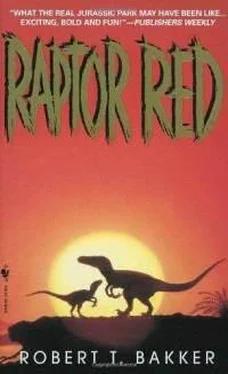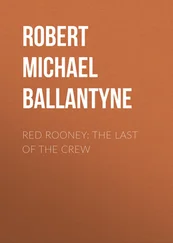But the metabolic furnace within her body is up to the thermal challenge. Waves of shivering spread through her muscles, and her heat production goes up by another factor of four, keeping all her vital organs at an optimum temperature of 100 degrees Fahrenheit.
Still, shivering eats up heat calories so fast that by day two of her trek, Raptor Red is ravenously hungry. She has to find meat - fuel for her hot-blooded body. She sniffs along the fern-tangled bank of a creek, now swollen with rainwater. She has learned from experience that meaty tidbits can be found washed up in just such locales.
She thrusts her snout into a clump of horsetail reeds.
Yeech! Her olfactory chambers are choked by the suffocating aroma of half-rotten lungfish.
More carefully now, she investigates the three-hundred-pound fish. Only half is totally disgusting. The rear half is edible. She cuts the offending front end off with her sharp foreclaws.
Gulp-chunk-chug. A hundred pounds of fish disappear down her gullet.
An hour later her careful streamside search is rewarded again: a dead turtle, twenty-five pounds, with its head bitten off - probably by a crocodile. One gulp and it’s gone, shell and all.
Raptors evolved as group hunters of big game. Raptor Red killed dozens of multi-ton dinosaurs when she hunted as part of a pair, first with a sibling, later with her mate. But evolution rewards flexibility too. A lone raptor is like a lone wolf…eat-eater who must be able to forage for small fry.
Raptor Red is surviving by herself, picking through the zoological garbage thrown up by the overflowing creek. She’s lucky. It’s an unusually wet spring. The turbid mixing of river, pond, and stream waters carries a rich hoard of dead and dying aquatic creatures. Her powerful olfactory sense serves her well in discovering carrion treasures hidden in places even the keenest eyes would never discover.
Raptor Red realizes that she is now following a faint scent-trail. Her olfactory nerves can just barely detect the presence, far upstream, of warm dinosaur bodies - raptor bodies - and the prospect of rejoining her own kind raises her spirits.
As she climbs over a logjam of conifer trunks, she stops and stares and sniffs, raises her snout as high as it will go, sniffs again loudly, and stares.
There are raptors, five of them, three hundred yards away.
But something is wrong. She gets a big dose of scent, and her olfactory nerves are overwhelmed with biochemical clues. Raptor scent, definitely. But her brain evaluates the scent-rich air and concludes: Raptors - but not MY KIND!
She’s suddenly angry and afraid, confronted by a raptor so close to her own scent and yet so distinctly wrong.
Two of the foreign raptors approach slowly, holding their heads low in a submissive, non-threatening posture.
She sniffs loudly. These are not small raptors. Too big to be Deinonychus, and the scent is wrong for Deinonychus.
Now she senses maleness in the two approaching raptors. They bob their heads in a greeting that’s almost like the way her mate used to greet her.
But there’s something wrong in their head-bobbing dance too. These foreign males don’t do it right, and their flawed choreography makes her even more agitated.
My kind… not my kind… Her brain struggles with the mixed signals.
Now she can see the color band on their snouts. It’s not red. It’s yellow. She has never been with a family member with a yellow snout patch.
She thinks to herself. Images of self-recognition express, My kind, red snout - my kind, Raptor - Red.
HsssscreeeeEEEEEEECH!!!!
Her brain can’t stand it anymore. She attacks, making huge deadly arcs with her deadliest claw.
She kicks up dust. She swooshes her tail from side to side.
The two foreign males freeze for a second, then bound away in full-speed retreat.
Then Raptor Red turns and runs away too.
She has no conscious way of understanding what has just happened. Deep inside her brain, the thought of being courted by Yellow Snouts is hateful.
The most important task she has had to perform, all through her life, ever since hatching, has been to identify my kind. To Raptor Red, the Yellow Snouts are hideous liars and impostors. They have most of the correct signals for my kind, yet they distort proper Utahraptor language and use foreign movements, and they give out the wrong scent.
Raptor Red snarls to herself, paces back and forth, and flexes her killing-claw in angry spasms. She’s sure she has saved herself from some hideous, unknown fate. And she has. If she had mated with a Yellow Snout, he would have abandoned her. And she would have been cursed with chicks born dead or deformed or sterile.
Raptor Red doesn’t know that this hatred is what has kept her species alive. It’s her hate of Yellow Snouts that protects her own reproductive hopes. Any Red Snout attracted to a Yellow Snout mate would condemn her own genes to death. The hybrid chicks would never survive to a healthy adulthood. Natural selection has to be ruthless - genes that encourage such lethal unions are weeded out by death and infertility.
Raptor Red’s inborn horror of Yellow Snouts is reinforced by dim memories from childhood. She saw her kind, her parents, drive them away. Back in her homeland in Asia, Yellow Snouts were distant neighbors who hunted in the densely forested highlands. Raptor Red’s species preferred the more open low country. When members of the two species met, they fled, or they attacked.
Even when she was a chick, Raptor Red’s nose told her that Yellow Snouts were almost my kind. Her nose told the truth. Yellow Snouts are her ancestors.
Fifty thousand years before, the two species had been one and the same, a mountain-loving yellow-muzzled predator. Yellow Snouts kept to the ancestral habitats of dense forests, but a small part of the ancestral population became isolated on the far side of a huge river. That small population evolved different hunting techniques, different recognition colors, and different courtship colors. It became a new Utahraptor species, Raptor Red’s species.
When the red-snouted Utahraptors finally met their yellow-snouted kin, their genes could no longer mix.
Raptor Red’s species is lucky to be alive. New species are evolutionary experiments that usually turn out to be inferior to the parent species. And parent species usually exterminate their daughters.
But not the Red Snouts. Their adaptive equipment proved superior to their ancestor’s, and when the two met, Red Snouts usually pushed out Yellow Snouts, the daughter species exterminating the parent species like Darwinian Lizzie Bordens.
Here and there the two can coexist, wherever especially dense cover permits the Yellow Snouts to escape their more aggressive red-snouted kin.
Raptor Red moves away at a quick pace, still agitated from her meeting with her near relations. If she were with her family, she’d attack. But she’s alone, and she wants to get away, so she descends into a low series of dry lake beds that offer ground more to her liking than the coniferous woodland where the Yellow Snout pack is staking out their hunting territory.
Here she stays for a week. She is searching for a Utahraptor of her kind.
TOO SKINNY FOR PARENTHOOD (AND TOO FULL OF TICKS)
MAY
Raptor Red knows she’s too skinny. She looks at her thigh, pokes at it with her snout, and looks again. It’s muscular but very lean. Two weeks on her own have been hard on her diet. A single Utahraptor is not an efficient predator, and she has subsisted on the equivalent of raptor finger food…ead croc here, a half-decayed lungfish there, a dried-up iguanodon carcass in between.
Male Utahraptors prefer plump, well-fed females.
Читать дальше












